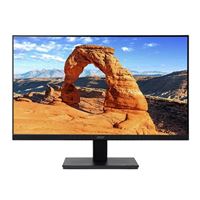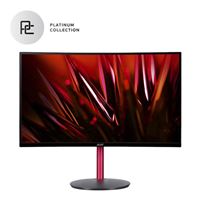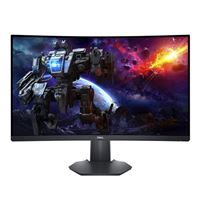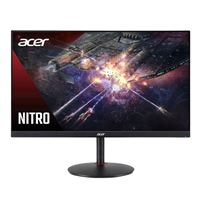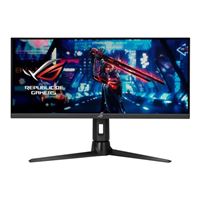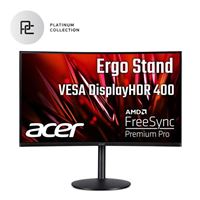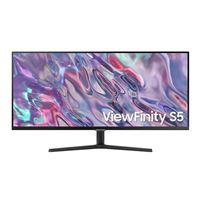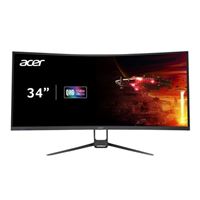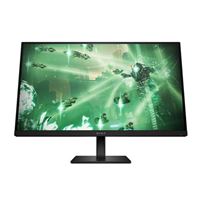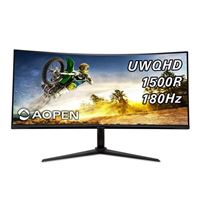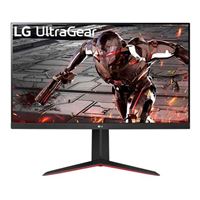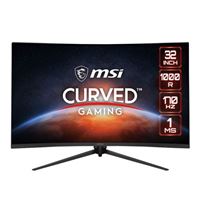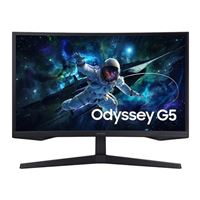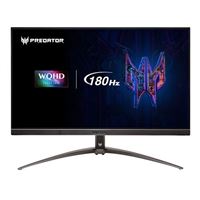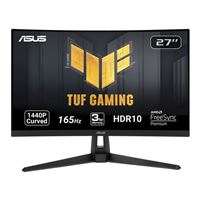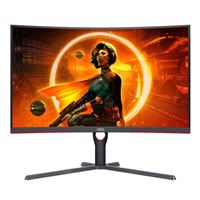Special Offers / Advertisements
Compare up to 4 items
New list of matching products
X
Sorry, you may compare a maximum of 4 items at a time.
Please clear one or more of your compare items before adding another-
SKU: 648659
- AMD Freesync
- HDMI DisplayPort
- 3-Sided Frameless
- Acer VisionCare
- AMD Freesync
- HDMI DisplayPort
- 3-Sided Frameless
25+ IN STOCK at Fairfax StoreOur price $129.99Original price $179.99Save $50.00 -
SKU: 592881
- AMD FreeSync
- HDMI DisplayPort
- Acer EyeProtection
- ZeroFrame Design
- AMD FreeSync
- HDMI DisplayPort
- Acer EyeProtection
2 IN STOCK at Fairfax StoreOur price $149.99Original price $199.99Save $50.00 -
SKU: 542530
- HDMI DisplayPort
- Acer VisionCare
- ZeroFrame
- HDMI DisplayPort
- Acer VisionCare
- ZeroFrame
1 IN STOCK at Fairfax StoreOur price $153.87Original price $189.97Save $36.10 -
SKU: 539940
- AMD FreeSync
- HDR
- HDMI DisplayPort
- ZeroFrame Design
- Blue Light Filter
0 IN STOCK at Fairfax StoreOur price $179.99Original price $279.99Save $100.001 open box from $143.96 -
SKU: 604496
- AMD FreeSync Premium
- HDR
- HDMI Displayport
- 3-Sided Frameless
- AOPEN Eye Protection
- AMD FreeSync Premium
- HDR
- HDMI Displayport
25+ IN STOCK at Fairfax StoreOur price $179.99 -
SKU: 640482
- AMD FreeSync Premium
- HDR
- HDMI DiplayPort
- 3-Side Virtually Borderless Design
- Low Blue Light
- AMD FreeSync Premium
- HDR
- HDMI DiplayPort
4 IN STOCK at Fairfax StoreOur price $179.99Original price $199.99Save $20.00 -
SKU: 682385
- AMD Freesync Premium
- HDMI DisplayPort
- Flicker-Free
- Game Enhance Mode
- AMD Freesync Premium
- HDMI DisplayPort
- Flicker-Free
10 IN STOCK at Fairfax StoreOur price $189.99 -
SKU: 616631
- AMD FreeSync Premium
- HDR
- HDMI DisplayPort
- Acer VisionCare
- 3-Side Virtually Borderless Display
- AMD FreeSync Premium
- HDR
- HDMI DisplayPort
25+ IN STOCK at Fairfax StoreOur price $199.99Original price $299.99Save $100.00 -
SKU: 668830
- Adaptive-Sync
- HDR
- HDMI DisplayPort
- Frameless Design
- Night Vision Mode
- Adaptive-Sync
- HDR
- HDMI DisplayPort
8 IN STOCK at Fairfax StoreOur price $199.99Original price $229.99Save $30.00 -
SKU: 681809
- NVIDIA G-Sync Compatible / AMD Freesync Premium
- HDR
- HDMI DisplayPort
- Aura Sync Lighting
- KVM Switch
- NVIDIA G-Sync Compatible / AMD Freesync Premium
- HDR
- HDMI DisplayPort
10 IN STOCK at Fairfax StoreOur price $219.99Original price $399.99Save $180.00 -
SKU: 543694
- AMD FreeSync
- HDR
- HDMI DisplayPort
- Zero Frame
- Acer VisionCare
14 IN STOCK at Fairfax StoreOur price $219.99Original price $299.99Save $80.00 -
SKU: 677765
- AMD Freesync
- HDR
- HDMI DisplayPort
- Picture-in-Picture
- Eye Saver Mode
- AMD Freesync
- HDR
- HDMI DisplayPort
2 IN STOCK at Fairfax StoreOur price $229.99Original price $279.99Save $50.00 -
SKU: 695148
- AMD FreeSycn Premium
- HDR
- HDMI DisplayPort
- On-screen controls
- 3-Sided Frameless
- AMD FreeSycn Premium
- HDR
- HDMI DisplayPort
3 IN STOCK at Fairfax StoreOur price $229.99Original price $279.99Save $50.00 -
SKU: 616136
- NVIDIA G-Sync Compatible
- HDR
- HDMI DisplayPort
- Sharper Image Quality
- 3-Side Virtually Borderless Display
- NVIDIA G-Sync Compatible
- HDR
- HDMI DisplayPort
25+ IN STOCK at Fairfax StoreOur price $229.992 open box from $183.96 -
SKU: 406496
- FreeSync
- HDMI, DisplayPort
- Blue Light Filter
- Flicker-Free
- FreeSync
- HDMI, DisplayPort
- Blue Light Filter
1 IN STOCK at Fairfax StoreOur price $229.99Original price $259.99Save $30.00 -
SKU: 673889
- AMD FreeSync Premium
- HDR
- HDMI DisplayPort
- Eyesafe Certification
- Console Mode
- AMD FreeSync Premium
- HDR
- HDMI DisplayPort
1 IN STOCK at Fairfax StoreOur price $229.99Original price $259.99Save $30.001 open box from $183.96 -
SKU: 667063
- AMD FreeSync Premium
- HDMI DisplayPort
- Eye Protection
- 1ms Turbo Visual Response
- AMD FreeSync Premium
- HDMI DisplayPort
- Eye Protection
17 IN STOCK at Fairfax StoreOur price $249.99Original price $329.99Save $80.00 -
SKU: 666461
- AMD FreeSync Premium Pro
- HDR
- HDMI DisplayPort
- 3-Sided Frameless
- Low Motion Blur
- AMD FreeSync Premium Pro
- HDR
- HDMI DisplayPort
4 IN STOCK at Fairfax StoreOur price $249.99Original price $299.99Save $50.001 open box from $199.96 -
SKU: 591404
- FreeSync
- HDMI DisplayPort
- FreeSync
- HDMI DisplayPort
5 IN STOCK at Fairfax StoreOur price $249.99Original price $279.99Save $30.001 open box from $207.96 -
SKU: 658971
- AMD FreeSync Premium
- HDR
- HDMI DisplayPort
- Eye Saver Mode
- Auto Source Switch
- AMD FreeSync Premium
- HDR
- HDMI DisplayPort
7 IN STOCK at Fairfax StoreOur price $249.99Original price $349.99Save $100.00 -
SKU: 560953
- AMD FreeSync
- HDMI DisplayPort
- 3-Sided Frameless
- HP Eye Ease Technology
- AMD FreeSync
- HDMI DisplayPort
- 3-Sided Frameless
1 IN STOCK at Fairfax StoreOur price $249.99Original price $299.99Save $50.001 open box from $174.96 -
SKU: 689588
- AMD FreeSync Premium
- HDR
- HDMI DisplayPort
- Acer VisionCare
- 3-Side Virtually Borderless Display
- AMD FreeSync Premium
- HDR
- HDMI DisplayPort
4 IN STOCK at Fairfax StoreOur price $249.99Original price $349.99Save $100.00 -
Free 3 month Adobe Creative Cloud Subscription with this product
SKU: 150219
- FreeSync
- HDR
- HDMI DisplayPort
- Blue Light Filter
10 IN STOCK at Fairfax StoreOur price $249.991 open box from $199.96 -
SKU: 554279
- AMD FreeSync Premium
- HDR
- HDMI DisplayPort
- Flicker Safe
- AOC's eSaver
- AMD FreeSync Premium
- HDR
- HDMI DisplayPort
12 IN STOCK at Fairfax StoreOur price $279.99Original price $299.99Save $20.00
Special Offers / Advertisements
{
'name': 'EK271U Ebiip 27" 2K QHD (2560 x 1440) 100Hz LED Monitor',
'id': '674791',
'price': '129.99',
'brand': 'Acer',
'category': 'Computer Monitors|575',
'list': 'Search Results',
'position': 1
},{
'name': 'KA272U biipx 27" 2K QHD (2560 x 1440) 75Hz LED Monitor',
'id': '668457',
'price': '149.99',
'brand': 'Acer',
'category': 'Computer Monitors|575',
'list': 'Search Results',
'position': 2
},{
'name': 'V277U bmiipx 26.95" 2K WQHD (2560 x 1440) 75Hz LED Monitor',
'id': '663341',
'price': '153.87',
'brand': 'Acer',
'category': 'Computer Monitors|575',
'list': 'Search Results',
'position': 3
},{
'name': 'XZ272U Vbmiiphx 27" 2K WQHD (2560 x 1440) 165Hz Curved Screen Gaming Monitor Platinum Collection',
'id': '663060',
'price': '179.99',
'brand': 'Acer',
'category': 'Computer Monitors|575',
'list': 'Search Results',
'position': 4
},{
'name': '27HC5UR P2bmiipx 27" 2K WQHD (2560 x 1440) 170Hz Curved Screen Gaming Monitor',
'id': '669941',
'price': '179.99',
'brand': 'Acer',
'category': 'Computer Monitors|575',
'list': 'Search Results',
'position': 5
},{
'name': 'G27CQ4 E2 27" 2K WQHD (2560 x 1440) 170Hz Curved Screen Monitor',
'id': '674148',
'price': '179.99',
'brand': 'MSI',
'category': 'Computer Monitors|575',
'list': 'Search Results',
'position': 6
},{
'name': 's2722dgm 27" 2K QHD (2560 x 1440) 165Hz Curved Screen Monitor (Refurbished)',
'id': '678057',
'price': '189.99',
'brand': 'Dell',
'category': 'Computer Monitors|575',
'list': 'Search Results',
'position': 7
},{
'name': 'Nitro XV272U V3bmiiprx 27" 2K WQHD (2560 x 1440) 180Hz Gaming Monitor',
'id': '671227',
'price': '199.99',
'brand': 'Acer',
'category': 'Computer Monitors|575',
'list': 'Search Results',
'position': 8
},{
'name': 'G32CQ5P 31.5" 2K WQHD (2560 x 1440) 170Hz Curved Screen Gaming Monitor',
'id': '677055',
'price': '199.99',
'brand': 'MSI',
'category': 'Computer Monitors|575',
'list': 'Search Results',
'position': 9
},{
'name': 'XG309CM 29.5" 2K QHD (2560 x 1080) 220Hz Gaming Monitor',
'id': '677918',
'price': '219.99',
'brand': 'ASUS',
'category': 'Computer Monitors|575',
'list': 'Search Results',
'position': 10
},{
'name': 'EI322QUR Sbmiipphx 31.5" 2K WQHD (2560 x 1440) 165Hz Curved Screen Gaming Monitor Platinum Collection',
'id': '663366',
'price': '219.99',
'brand': 'Acer',
'category': 'Computer Monitors|575',
'list': 'Search Results',
'position': 11
},{
'name': 'S34C5 34" 2K QHD (3440 x 1440) 100Hz Gaming Monitor',
'id': '678026',
'price': '229.99',
'brand': 'Samsung',
'category': 'Computer Monitors|575',
'list': 'Search Results',
'position': 12
},{
'name': 'Nitro EDA343CUR 34" 2K WQHD (3440 x 1440) 100Hz Curved Screen Monitor',
'id': '679699',
'price': '229.99',
'brand': 'Acer',
'category': 'Computer Monitors|575',
'list': 'Search Results',
'position': 13
},{
'name': 'Armada 27" 2K QHD (2560 x 1440) 165Hz Gaming Monitor',
'id': '671196',
'price': '229.99',
'brand': 'HyperX',
'category': 'Computer Monitors|575',
'list': 'Search Results',
'position': 14
},{
'name': 'SE2723DS 27" 2K QHD (2560 x 1440) 75Hz LED Monitor',
'id': '649786',
'price': '229.99',
'brand': 'Dell',
'category': 'Computer Monitors|575',
'list': 'Search Results',
'position': 15
},{
'name': 'OMEN 27q 27" 2K QHD (2560 x 1440) 165Hz Gaming Monitor',
'id': '677782',
'price': '229.99',
'brand': 'HP',
'category': 'Computer Monitors|575',
'list': 'Search Results',
'position': 16
},{
'name': '34HC5CU S3biiphx 34" 2K WQHD (3440 x 1440) 180Hz Curved Screen Gaming Monitor',
'id': '676973',
'price': '249.99',
'brand': 'AOpen',
'category': 'Computer Monitors|575',
'list': 'Search Results',
'position': 17
},{
'name': '32GN650-B.AUS UltraGear 31.5" 2K QHD (2560 x 1440) 165Hz Gaming Monitor',
'id': '676922',
'price': '249.99',
'brand': 'LG',
'category': 'Computer Monitors|575',
'list': 'Search Results',
'position': 18
},{
'name': 'Optix G321CQP 31.5" 2K WQHD (2560 x 1440) 165Hz Wide Curved Screen Gaming Monitor',
'id': '668295',
'price': '249.99',
'brand': 'MSI',
'category': 'Computer Monitors|575',
'list': 'Search Results',
'position': 19
},{
'name': 'Odyssey G5 S32CG55 32" 2K WQHD (2560 x 1440) 165Hz Wide Curved Screen Gaming Monitor',
'id': '676013',
'price': '249.99',
'brand': 'Samsung',
'category': 'Computer Monitors|575',
'list': 'Search Results',
'position': 20
},{
'name': 'M27fq 27" 2K QHD 2560 x 1440) 75Hz LED Monitor',
'id': '665418',
'price': '249.99',
'brand': 'HP',
'category': 'Computer Monitors|575',
'list': 'Search Results',
'position': 21
},{
'name': 'Predator XV273U V3bmiiprx 27" 2K WQHD (2560 x 1440) 180Hz Gaming Monitor',
'id': '679104',
'price': '249.99',
'brand': 'Acer',
'category': 'Computer Monitors|575',
'list': 'Search Results',
'position': 22
},{
'name': 'VG27WQ1B 27" 2K WQHD (2560 x 1440) 165Hz Curved Screen Gaming Monitor',
'id': '626548',
'price': '249.99',
'brand': 'ASUS',
'category': 'Computer Monitors|575',
'list': 'Search Results',
'position': 23
},{
'name': 'CQ32G3SU 32" 2K WQHD (2560 x 1440) 165Hz Curved Screen Gaming Monitor',
'id': '664591',
'price': '279.99',
'brand': 'AOC',
'category': 'Computer Monitors|575',
'list': 'Search Results',
'position': 24
}
{'id': 'Tower',
'name': 'Nanoleaf Monitor Tower October 2021',
'creative': 'https://60a99bedadae98078522-a9b6cded92292ef3bace063619038eb1.ssl.cf2.rackcdn.com/images_ads_2021Search_October_nanoleaf_shapes_tower.png',
'position': '1' },{'id': 'Tower',
'name': 'Kanto Monitor Tower January 2020',
'creative': 'https://60a99bedadae98078522-a9b6cded92292ef3bace063619038eb1.ssl.cf2.rackcdn.com/images_ads_2021Search_October_KantoDMS2000st.png',
'position': '2' },{'id': 'Tower',
'name': 'Micro Center eNews Banner',
'creative': 'https://60a99bedadae98078522-a9b6cded92292ef3bace063619038eb1.ssl.cf2.rackcdn.com/webp_MCNewsST.webp',
'position': '3' }






